Fallout 4 How To Get Out Of Power Armor
| | Cleanup (Issue: major reference checks needed, needs trimming, overview should not include entire articles, just a small section for each, leading to separate articles) To meet Nukapedia 's quality standards, this article or section may require cleanup. Please help by improving the article. |
|---|
| Gameplay articles | ||||||||||||||||||||||||||||||||||||||||||||||||
|---|---|---|---|---|---|---|---|---|---|---|---|---|---|---|---|---|---|---|---|---|---|---|---|---|---|---|---|---|---|---|---|---|---|---|---|---|---|---|---|---|---|---|---|---|---|---|---|---|
| ||||||||||||||||||||||||||||||||||||||||||||||||
| | This is an overview article, listing content appearing across multiple games. |
|---|
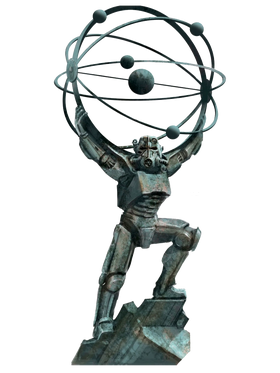
Power armor is a personal infantry combat technology developed before the Great War by United States defense contractors. It represents the pinnacle of personal defensive technology, combining excellent protection from small arms with the ability to carry heavy weapons into combat with ease.[Non-game 1]
The first iteration of power armor successfully deployed in combat was the T-45 model, which originally ran on small energy cells. In response to burning through the cells at an alarming rate, later versions were manufactured with built-in microfusion packs. The T-45 model played a crucial role in stabilizing the Alaskan frontlines at the time of its introduction, while the superior T-51 power armor and later models helped decisively shift the balance in the United States' favor during the Sino-American War.
Stealth armor was the initial Chinese response, focusing on stealth and subterfuge, rather than head-on confrontations. China would still attempt to create their own versions of power armor but were already many years behind the United States.[Non-canon 1]
After the Great War, power armor rapidly became a precious, treasured item, with only a limited number of factions capable of maintaining or fielding them in substantial numbers, much less manufacturing them. Among these are the technologically advanced Brotherhood of Steel and the Enclave.
In the games themselves, power armor is a highly protective type of sophisticated armor. In Fallout, Fallout 2, and Fallout Tactics it is effectively the endgame armor, wildly exceeding every other option in terms of protection and bonuses. In Fallout 3 and Fallout: New Vegas power armor is still a profoundly protective armor but is gated behind Power Armor Training. It serves less as a clear cut endgame armor and more of an endgame option for characters specializing in heavy armor. Finally, in Fallout 4 and Fallout 76, power armor was developed into a separate gameplay system consisting of maintenance and repair not used for other armor, requiring periodic refueling with fusion cores and allowing in-depth customization.
Contents
- 1 History
- 2 Power armor models
- 2.1 T-45 power armor
- 2.2 T-51 power armor
- 2.3 T-60 power armor
- 2.4 T-65 power armor
- 2.5 X-01 power armor
- 2.6 Advanced power armor Mark I
- 2.7 Advanced power armor Mark II
- 2.8 Hellfire power armor
- 2.9 EX-17 Excavator power armor
- 2.10 Raider power armor
- 2.11 Chinese power armor
- 3 Non-canon models
- 3.1 Eastern Brotherhood power armor
- 3.2 Vault-Tec power armor
- 4 Gameplay
- 4.1 Fallout
- 4.2 Fallout 2
- 4.3 Fallout Tactics
- 4.4 Fallout 3
- 4.5 Fallout: New Vegas
- 4.6 Fallout 4
- 4.7 Fallout 76
- 5 Gallery
- 6 References
History
With the resource crisis severely limiting the ability of the United States military to deploy combat vehicles, especially tanks and other types of armor, the military-industrial complex began research efforts to create self-powered combat suits in August 2065. Mechanized cavalry units provided with them would retain the mobility of a soldier moving on foot while giving them the ability to use heavy weapons with ease.[1] Research proceeded rapidly. While early prototypes were unsuccessful, lessons learned in the process paved the way for future advances in military sciences, construction, and fusion.[Non-canon 1]
The most important achievement of this early stage of research was the development of a fusion cell. Crude, but effective, the design was unveiled to the world in the summer of 2066. It further strained Sino-American relations, after the United States refused to share its crude oil reserves with the Asian superpower. The invasion of Alaska in winter of 2066 forced the military and its contractors to begin producing the first sets of powered infantry combat armor. In 2067, the first West Tek production model of powered infantry combat armor designated T-45 was sent off to the frontline to defend against the Chinese attackers. Although lacking in mobility, this early model allowed soldiers to carry heavy weapons into combat,[1] becoming key to countering masses of Chinese infantry and tanks. China rushed to develop its own version, but it was years behind the United States.[Non-canon 1]
Anticipating this move, the military invested in the development of electromagnetic weapons to counter the threat should it arise.[2] In a way, China engineered its own demise, as the deployment of the T-45 also led to the development of the West Tek power armor frame, the basis on which all subsequent armor was manufactured.[1]
Meanwhile, West Tek continued developing a superior model, designated T-51. By 2069, it was the largest contract of the largest defense contractor of the United States government. However, the ambitious nature of the project led to many delays and it took nearly ten years to complete the development cycle.[Non-canon 1] [3] In the meantime, the T-45d became the symbol of American might. Various modifications were developed and tested using it as a basis, including the MP-47A unit, featuring an autonomous medical delivery system and rudimentary onboard AI.[4]
In 2074, American T-45 model D power armor units, mechanized cavalry, and infantry divisions invaded mainland China. However, the invasion quickly bogged down as the T-45's aging design proved insufficient to overcome the Chinese defenders. The T-51 model power armor remained in development, with various production models being tested in combat conditions at Fort Strong in Massachusetts, troubleshooting the design. Problems were still present this far into the development cycle, delaying deployment. For instance, the September 2075 iteration had the desired mobility and protection but were far from stable and soldiers tended to tip over on hard landings. Gyroscopic stabilizers and shock absorbers were subsequently added.[5]
However, the problems were eventually ironed out and the joint efforts of West Tek and Fort Strong resulted in the first production run of T-51 power armor being sent to China in June 2076.[6] [7] It outperformed the T-45d in every aspect, providing the United States with the means to overcome Chinese resistance on all fronts. Many units were sent to China, where the renewed American offensive finally sent the People's Liberation Army into retreat.[Non-canon 1] In January 2077, General Constantine Chase completed the Anchorage Reclamation, using winterized T-51b power armor troops as spearhead.[Non-game 2] The completion of the Anchorage Reclamation also coincided with the introduction of the T-60 power armor, developed first as an upgrade of the T-45 series, then spun-off into a separate series.[8] [Non-game 3]
The Great War and the destruction of the United States ensured that the T-51 model B (T-51b) and T-60 power armor remained the most advanced designs to see mass production. Limited-runs of other models were made to accommodate various branches, such as the T-65 power armor for the Secret Service.[9] More advanced and sophisticated power armor models were in development: The U.S. government initiated the development of the next generation of power armor, designated X-01.[10] The complexity of the new armor, however, meant development progress was slow. Tests on the completed X-01 prototype models ultimately revealed design flaws that would prevent full production. These design issues were not overcome before the start of the Great War leaving very few units of X-01 produced, although the schematics were saved and backed up by the Enclave just prior to the bombs falling.[11]
In the years that followed the bombs falling, power armor development was effectively halted. In 2198, the Enclave would restart work on developing advanced versions of power armor. While initially their progress was slow, a Presidential Order mandating the development of an upgrade in 2215 would alter things greatly. Five years later, the first advanced power armor was developed and mass-produced for the use of Enclave field units. Existing T-51 stock was used for training troops on Control Station Enclave and logistical duties.[Non-game 4]
Later on, by using cutting edge composite material an equally durable but lighter model of armor the Advanced power armor Mk II was made, however, it was only made in small amounts before production was hampered by the destruction of the oil rig by the Chosen One in 2242. The death of key personnel during the event, along with the loss of many Enclave resources was a heavy blow to the survivors. In the wake of the event, the survivors were forced to resort to using subpar models of Enclave power armor for a time that in many ways were inferior to pre-war models. This state of affairs would continue until segments of the Enclave eventually arrived in the Capital Wasteland and settled into Adams Air Force Base. There a reexamination of past combat data and older failed prototype armors was commenced alongside research into new materials. The result of this subsequent research was the next-generation Enclave Hellfire armor: Pinnacle of post-War power armor design.[12] [13]
Power armor models
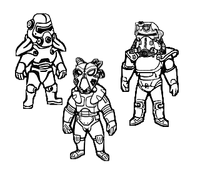
All power armor models in the United States share a common heritage and basic design. Each power armor is built around the West Tek power armor frame,[Non-game 5] with an internalized servomotor system, providing increased strength, resistance to trauma, and radiation protection. The operator controls the armor indirectly, using manipulators that steer the hands and feet while being safely isolated from the environment. Of note is integrated hydraulic shock absorption system which allows the operator to jump from major heights without damage.[1] [14] The safety of airborne deployments depends primarily on the model of the armor, with the survivable height for early T-60 models being about one hundred feet,[15] increased to more than three times the height in later iterations.[16]
Naturally, the enhanced strength also allows the use of hard armored plating that would otherwise be impossible for the soldier to carry with ease.[Non-game 6] The basic version of each power armor is designated model A - the letter is usually omitted in this case - with subsequent revisions and upgrades distinguished using sequential letters: B, C, D, E, and F. Each represents an incremental upgrade over the preceding model. Beyond general revisions, a large number of upgrades and custom internals has been developed for the various power armor units, to increase their flexibility and performance on the battlefield.[17]
The power necessary for the unit to operate autonomously comes from a fusion power plant integrated into the chassis of the suit,[18] typically loaded on the factory floor with fuel to last a hundred years of moderate use.[19] [20] [1] Salvaging power armor is also difficult, as the amount of firepower necessary to accomplish this feat renders the armor useless.[21]
Although the United States military remained the principal operator of power armor, select private corporations had access to the technology. One of which, the Garrahan Mining Company, used the West-Tek power armor technology to create a competitive powered mining suit, the Excavator power armor, in a bid to defeat its competitors and secure lucrative contracts for exploiting Appalachian natural resources.[22] [23]
T-45 power armor

The T-45 powered combat infantry armor was one of the earliest designs pressed into service in the Sino-American War. Created in January 2067 by West Tek,[24] the T-45 was sent to the Alaskan Front to counter the Chinese offensive. The speed at which it had to be deployed, less than two years after the development of power armor began, resulted in the creation of a stop-gap model utilizing existing technologies and manufacturing techniques. However, its deployment changed the nature of modern warfare forever.[24] Although intended to be temporary, the T-45 became the mainstay of American power armor units, especially as subsequent upgrades reduced the impact of the mobility problems that plagued the early production runs.[Non-canon 1]
T-51 power armor

A pre-War product of West Tek in conjunction with the United States government, T-51 power armor is made of a poly-laminate composite, shielding the user from radiation and damage while providing increased strength.[25] [26] Apart from military use, the corporation Grafton Steel attempted to create their own variant, codenamed Project Phoenix, resulting in a helmet reaching the prototype stage before the war.[27]
T-60 power armor

The T-60 series of powered combat infantry armor is an evolution of the T-45 power armor design.[Non-game 7] It entered service after the conclusion of the Battle of Anchorage, mere months before the nuclear apocalypse, the T-60 was rapidly deployed and extensively used by the U.S. Army in all theaters. Deployments of military units in T-60 power armor included the domestic front, enforcing order in the nation.[28] By the time of the Great War it was considered to be the most advanced model of power armor to see extensive use.[29]
As with other power armor models, the T-60 is designed for a single operator. As usual for T-series power armor, the helmet completes the ensemble and includes an air filtration system, a bullet-proof vision slit, an electric lamp, and external ports that allow the operator to listen to his surroundings and double as attachments points for extensions. The standard upgrade is a drop-down ocular.[30] Any shortcomings of the T-60 were compensated for through deployment: a T-60 power armor unit was usually deployed with support from light infantry units, equipped with energy weapons.[31]
Its variants include Tesla T-60.
T-65 power armor

The T-65 series is a unique set of power armor that saw development right before the Great War, but no production models are known to exist. Schematics were entrusted to the Secret Service agents stationed at Vault 79. T-65 series utilizes radically different protection principles from the previous power armor series with a departure from whole cast armor pieces to segmented armor layers notable in the torso piece and the pauldrons. This allowed the T-65 series to protect exposed frame sections and other areas that would be thinly armored on other power armor series and greatly increasing protection and survivability.
X-01 power armor

Commissioned by the Joint Chiefs, the development of the X-01 began shortly before the Great War.[11] It represented a radically new approach to designing powered armor, eschewing traditional design philosophies that defined the T series,[Non-game 8] and was a high-profile research project meant to supersede previous power armor models. A single suit of X-01 was provided to the Nuka-Cola Corporation, as part of Project Cobalt. While the suit served as a successful proof of concept of using a strontium-90 based plating over the armor,[32] this improvement was not adopted into the armor's schematics, before the onset of the Great War. Further development was made impossible due to the outbreak of the Great War.[11]
After the Great War, a select few suits were engineered further and employed by remnants of the U.S. military, like the Enclave and Brotherhood of Steel, as well as the Institute.[33] The schematics for the armor were saved by the Enclave just before the bombs fell, with the organization keeping copies in the archives of their Poseidon and Whitespring facilities, including Control Station ENCLAVE. This allowed the Enclave to create a limited production run of the suits, and for work to eventually continue on the model's development.[11]
Full development was restarted by the Enclave in 2198, although it wasn't until 2215 that the research efforts began in earnest under the presidential mandate, resulting in the creation of the first model of Advanced power armor in 2220. Another group to develop upon the X-01 design, after the war, is the Institute. Despite lacking access to the prototype's schematics, by 2287, the Institute had developed a modified polymerized casting mix to coat the armor, as well as other modifications that enhance the user's intelligence.[34] Variants include prototype X-01 power armor, Quantum X-01 power armor and X-01-I power armor.
Advanced power armor Mark I
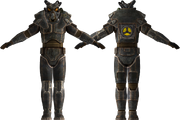
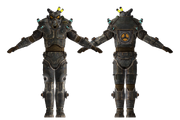
Unlike the pre-War Tesla armor, this armor is a variant of the Enclave's advanced power armor jury-rigged with a Tesla device that is capable of dispersing a large percentage of the damage done by directed-energy attacks. [citation needed]
Advanced power armor Mark II
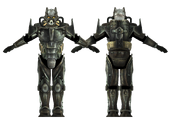
Also known as Enclave power armor,[35] X-02,[Non-canon 2] and Black Devil power armor,[36] the advanced power armor Mark II[37] was designed as a replacement for the older Mark I suit, which was planned to be phased out entirely. [citation needed] The Mk II is composed entirely of lightweight ceramic composites, providing protection superior to earlier models.[38] The Enclave was able to mass-produce the power armor at Raven Rock following the events of Fallout 2.[Non-game 9] [39] [13]
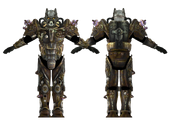
The advanced power armor Mk II may be modified with a Tesla device capable of dispersing a large percentage of the damage done by directed-energy attacks. [citation needed]
Hellfire power armor
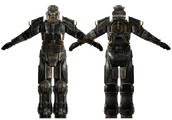
This armor is the result of a post-War research and development project undertaken by the Enclave. An early iteration was completed by October 2080, and was shipped to Vault 51 at the behest of the vault's ZAX computer[40] while the final mass-produced version would see large scale deployment in 2278. Initially, the mass-produced armor was one of several concurrently active research projects taking place at the Adams Air Force Base, including one on eyebots and a material called Duraframe, but ultimately came to be the most in-demand project fully completed; other projects, much to the chagrin of researchers such as Whitley, were canceled in favor of the new model of power armor by Colonel Augustus Autumn.[41]
EX-17 Excavator power armor

Developed by Garrahan Mining Co., the "Excavator" class of power armor was intended to help human miners compete with the growing number of robotic replacements. The prototype Excavator armor never saw full production, despite being heavily advertised in Appalachia as the future of mining.[42] This was due to Garrahan Mining losing a competition against Hornwright Industrial Mining company, where miners wearing the EX-17 competed against Hornwright's mining robots, thanks to Hornwright cheating during the competition.[43] Afterward, Hornwright Mining Co. bought out Garrahan Mining Co., including rights to the suit. Existing sets found new life in use by Responders[44] and the Vault Dwellers of Vault 76.
Raider power armor

This armor has been salvaged and restored to fighting shape by raiders, long after the Great War. It appears to incorporate elements of both the T-45 and T-51 models, although it has been rebuilt using primarily scrap metal. Its jury-rigged nature means that it can't protect as effectively against damage as other varieties of power armor. Variants include the Overboss power armor.
Chinese power armor
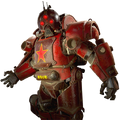
Non-canon models
Models in this section do not appear in canonical Fallout media.
Eastern Brotherhood power armor

| | The following is based on information from Fallout Tactics. |
|---|
A peculiar power armor with a distinctive, horned look employed by the Eastern Brotherhood of Steel operating in Chicago. Advanced models are composed of lightweight metal alloys and reinforced with ceramic castings at key points. [citation needed]
- Advanced power armor
Vault-Tec power armor

| | The following is based on information from Fallout: Brotherhood of Steel. |
|---|
This suit of armor was used by Vault-Tec in order to give some valuable combat equipment to their Secret Vault thus ensuring a successful entry into the post-apocalyptic world. It closely resembles the military's T-51b power armor.
- Advanced power armor
Gameplay
Power armor appears in every Fallout game. T-51b power armor and its hardened version appear in both Fallout and Fallout 2 while the latter also introduces the Enclave's advanced variants.
In Fallout 3 the T-45d power armor is the general power armor that can be found, as most members of the Brotherhood of Steel wear it. The Enclave's variant suits of power armor are also encountered. A pristine set of T-51b power armor is located in the Fort Constantine military base (but can only be obtained by doing a specific quest), and a winterized version of the same model can be found in the Fallout 3 Operation: Anchorage add-on. Fallout: New Vegas features the T-51b and the T-45d, while also bringing back the advanced power armor Mk I from Fallout 2; it also adds a new version, the Tesla power armor Mk I.
Fallout 4 features the T-51b and T-45d, as well as introducing the T-60 power armor as the new standard issued power armor for the East Coast Brotherhood of Steel. Also introduced was the X-01 power armor which was an experimental power armor created right before the bombs dropped. The Commonwealth raiders had also created salvaged power armor introducing raider power armor. Fallout 76 features the same power armor as Fallout 4, but introduces the Excavator power armor, which was developed by Garrahan Mining, but also the Ultracite power armor, which was an armor created with ultracite rather than poly-laminate composite.
Using a much different art style in general, Fallout Tactics shows the T-51b model only once in the introduction of the game, and the Midwestern Brotherhood power armor is used instead in the game, including an advanced version standing in for the Enclave's power armor. In Fallout: Brotherhood of Steel, two versions (regular and advanced) based on the T-51b with a similar appearance and a blue color appear in the Secret Vault and are created by Vault-Tec. The Fallout demo's item description references power armor.[Non-canon 3]
Fallout
- Power armor is endgame armor, with just two suits available, exclusively from the Brotherhood of Steel at Lost Hills: One from Talus for rescuing the initiate, the other from the maintenance bay, where the player can put together their own suit.
- The armor can also be hardened at Adytum, creating the best suit in the game.
Fallout 2
- Power armor remains the pinnacle of personal protection, now available in virtually unlimited quantities thanks to the San Francisco vendors. Several other suits are also found in the wild. The player can harden one of the T-51 suits in San Francisco as well.
- Edging the T-51 out is the advanced power armor, available as one unit: The standard advanced power armor at Navarro and an Mk II suit at the Enclave oil rig.
Fallout Tactics
- The game includes two models of power armor, one standard, and one advanced, both available to the player at Brotherhood bunkers in the late game. Although featuring steep penalties to Perception and various utility skills (among these a 75% penalty to Sneak), it remains the best suit of armor for every character in the endgame.
Fallout 3
- The player must receive training to be able to equip power armor. Non-player characters do not have this restriction.
- Training may be received at the Citadel from Paladin Gunny or by completing the Operation: Anchorage add-on mission before they can equip power armor. While being given the training, the Paladin tells the Wanderer to "relax their muscles" and "let the suit do the work".[45]
- Any weapon that is holstered on a character's back is normally hanging off the right shoulder diagonally with the barrel downwards. However, when wearing any form of power armor the gun is hanging diagonally off the left shoulder with the barrel pointing up. This is because power armor prevents the arm movements necessary to unholster the gun when it is in its normal position. Characters retrieve them under the arm, rather than over it. This was done to prevent clipping.
- Shooting at someone wearing power armor produces metallic sounds, decals, and particles (a metallic *clang* and sparks instead of flesh hit sound and blood spurts), despite still causing damage to the wearer. This is also true of the player character.
Fallout: New Vegas
- The Courier must receive Power Armor Training before they can utilize any form of the armor, except the NCR salvaged power armor, which has unique characteristics setting it apart from other variants. The training is available after either the Still in the Dark or For Auld Lang Syne quest has been completed.
- The sound of power armor has been changed. As opposed to Fallout 3, the servo-motors are no longer audible and there is no hydraulic fluid sound as the player character walks. In addition, NPC voices no longer have a 'speaker' effect and just sound muffled.
- Any weapon that is holstered on a character's back is normally hanging off the right shoulder diagonally with the barrel downwards. However, when wearing any form of power armor the gun is hanging diagonally off the left shoulder with the barrel pointing up. This is because power armor prevents the arm movements necessary to unholster the gun when it is in its normal position.
- Shooting at someone wearing power armor produces metallic sounds, decals, and particles (a metallic *clang* and sparks instead of flesh hit sound and blood spurts), despite still causing damage to the wearer. This is also true of the player character.
Fallout 4
- Power armor has undergone substantial changes in both size and gameplay mechanics as opposed to Fallout 3 and Fallout: New Vegas. Instead of being treated as a suit of armor that is equipped from the Pip-Boy, it is instead treated as a separate object, a vehicle more than a garment. In order to equip the armor, it must be entered from the outside by pressing the action button, which then causes the suit to unfold to accept an occupant, then reseals itself. In order to operate properly, power armor requires the use of a fusion core.
- No training is necessary to use a suit of power armor.
- Power armor allows its wearer to not only have superior strength bonuses but its armor components have their own hit points and actively absorb a substantial percentage of incoming damage until they are destroyed. The armor allows the wearer to fall from great heights without suffering any damage and simultaneously causes damaging shock waves to anything close by.
- Companions who enter power armor don't require fusion cores. Power armor increases the carrying capacity of companions much like it would the Sole Survivor, even more so if it is left bare.
Fallout 76
- Identical to Fallout 4, power armor has undergone substantial changes in both size and gameplay mechanics as opposed to Fallout 3 and Fallout: New Vegas. Instead of being treated as a suit of armor that is equipped from the Pip-Boy, it is instead treated as a separate object, a vehicle more than a garment. In order to equip the armor, it must be entered from the outside by pressing the action button, which then causes the suit to unfold to accept an occupant, then reseals itself. In order to operate properly, power armor requires the use of a fusion core.
- No training is necessary to use a suit of power armor.
- Power armor allows its wearer to not only have superior strength bonuses but its armor components have their own hit points and actively absorb a substantial percentage of incoming damage until they are destroyed. The armor allows the wearer to fall from great heights without suffering any damage and simultaneously causes damaging shock waves to anything close by.
- Power armor is exclusively owned by the player character after entering it, thus not allowing any other player characters to utilize it.
- The power armor chassis can be stored in the inventory with all pieces of armor remaining on it, as well as the fusion core.
- Power armor will be recalled to one's inventory after a period of time unless dropped.
Gallery
- Fallout
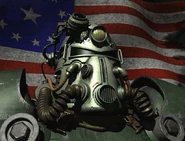
A United States soldier in T-51b Powered armor
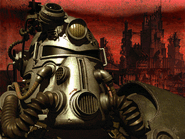
Box art
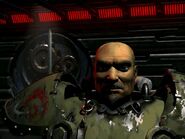
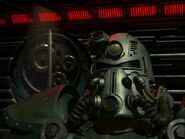
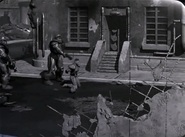
US soldier executing a Canadian freedom fighter
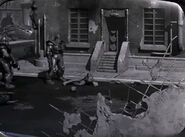
US soldier executing a Canadian freedom fighter
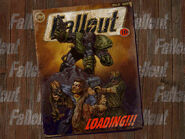
Loading screen

T-51b power armor helmet (representing the whole armor in the game inventory)

In-game T-51b power armor

In-game NPC wearing a piece of T-51b power armor without a helmet
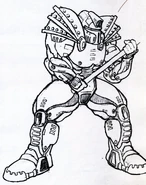
Fallout concept art
- Fallout 2
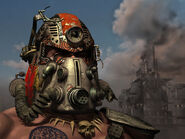
A broken T-51b helmet
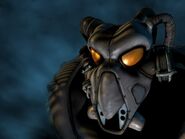
Advanced power armor
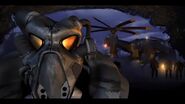
Enclave soldiers in advanced power armor
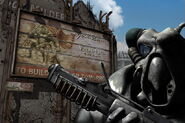
Enclave soldiers in advanced power armor in front of a pre-War poster depicting the T-51b power armor



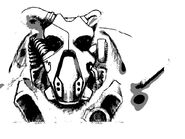
Concept art for the advanced power armor mark I

The advanced power armor in Fallout 2's inventory

The advanced power armor in Fallout 2
- Fallout 3
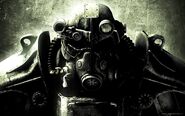
T-45d power armor
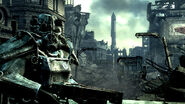
The T-45d power armor in the Fallout 3 teaser
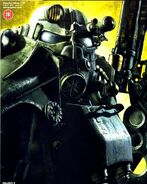
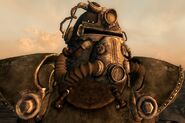
T-51b power armor
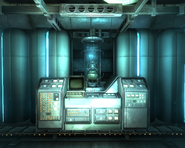
T-51b power armor in stasis
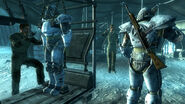
An US soldier donned with power armor and a mechanic repairing a T-51b suit.
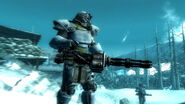
The US soldiers wearing the armor during the battle of Anchorage (zoomed in)
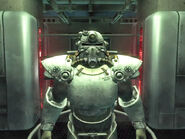
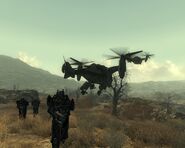
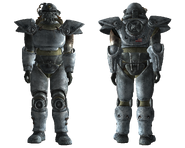
Winterized T-51b power armor
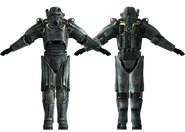
Brotherhood of Steel T-45d power armor
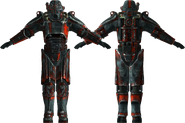
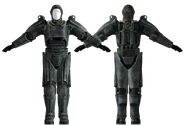
Army T-45d power armor

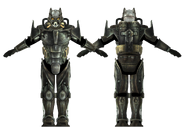
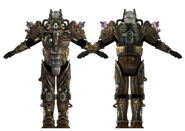
Tesla power armor
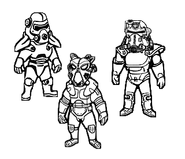
The 3 types of power armor icons
- Fallout: New Vegas
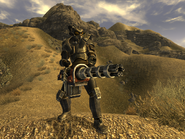
Remnants power armor
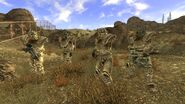
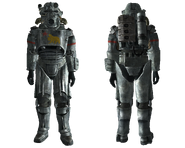
NCR salvaged T-45d power armor

Scorched Sierra power armor

T-45d power armor
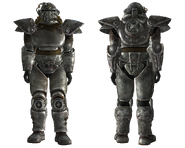
Brotherhood T-51b power armor
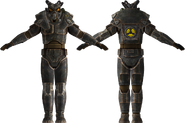
Remnants power armor
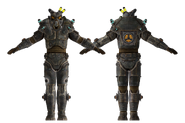
Tesla power armor Mk I
- Fallout 4
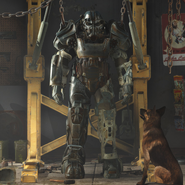
Power armor shown in the Fallout 4 official trailer
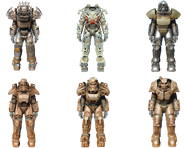
Different types of power armor in Fallout 4

Fallout 4 power armor concept art
- Fallout Shelter

T-45 power armor
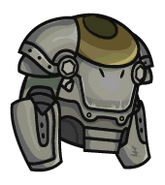
T-51 power armor
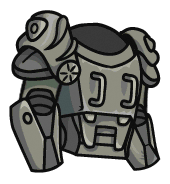
T-60 power armor
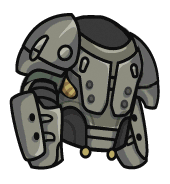
X-01 power armor
- Fallout Tactics
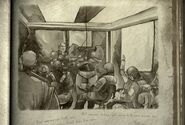
T-51b power armor
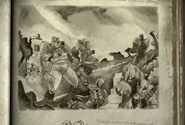
T-51b power armor

Midwestern Brotherhood power armor
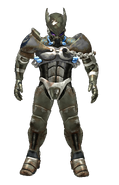
Advanced power armor

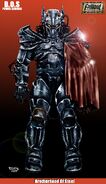
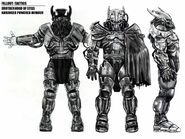



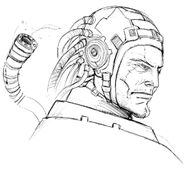
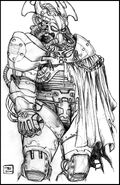
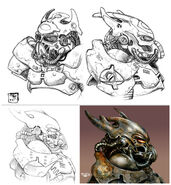
References
- ↑ 1.0 1.1 1.2 1.3 1.4 The Sole Survivor: "One good idea can make all the difference."
Preston Garvey: "Sturges? Tell him."
Sturges: "There's a crashed vertibird up on the roof. Old school. Pre-war. You might've seen it. Well, looks like one of its passengers left behind a seriously sweet goody. We're talking a full suit of cherry T-45 Power Armor. Military issue."
The Sole Survivor: "What makes that Power Armor so special?"
Sturges: "A West Tek internalized servo-system, that's what. Inside that baby, super is the new normal. You'll be stronger, tougher, resistant to rads. And... Get the suit, you can rip the minigun right off the vertibird. Do that, and those Raiders get an express ticket to Hell. You dig?"
The Sole Survivor: "And I can use the minigun like a... rifle?"
Sturges: "Don't see why not. It'll have a manual trigger. Just aim it at the bad guys, and do the ole' "spray and pray." Now, as for the armor... It's outta juice. Probably has been for a hundred years. It can be powered up again, but we're a bit stuck..."
(Preston Garvey and Sturges' dialogue) - ↑ The Courier: "What's a pulse gun?"
Veronica Santangelo: "Electromagnetic weapon from before the Great War. Experimental. It never saw mass production. But they were building it as a countermeasure to power armor, which they feared the Chinese were developing. Supposedly a prototype was being housed at Nellis. Imagine what it could do to the Brotherhood. We'd be on equal footing with any idiot with a gun."
(Veronica Santangelo's dialogue) - ↑ The Vault Dweller: "{207}{}{Base Information}"
ZAX 1.2: "{211}{}{West Tech Research Facility: Founded in 2002 as a private contractor for the United States government, the company initially consisted of two divisions--the Advanced Weapons Research and the Biomedical Sciences divisions.}
{241}{}{ In 2069, West Tech was the single largest contractor for the United States government; its largest contract being Powered Infantry Armor Model T-51b. }
{242}{}{In light of significant advances in 2076 by the NBC on the Pan-Immunity Virion Project, the United States Defense Department, in fear of international espionage,}
{243}{}{ moved a team onto the site to secure and oversee the project, now dubbed the FEV (Forced Evolutionary Virus) project.}"
(GPWRTERM.MSG) - ↑ Medic power armor manual
- ↑ Fort Strong terminal entries; General Brock's terminal, General Brock's Report - September 2075
- ↑ Fort Strong terminal entries; General Brock's terminal, General Brock's Report - June 2076
- ↑ Fallout 4 loading screens: "The T-51 series of Power Armor was the pinnacle of mechanized protection before the Great War. First introduced in the Battle of Anchorage, it is highly valued today for its increased protective capabilities."
- ↑ Fallout 4 loading screens: "The T-60 series of Power Armor saw extensive use by the United States Army after the Battle of Anchorage. In fact, soldiers in T-60 Power Armor were among those trying to retain order on October 23, 2077 - the day America fell to atomic war..."
- ↑ Used exclusively by the Secret Service.
- ↑ Fallout 4 loading screens: "The X-01 series of Power Armor was specially engineered and employed by remnants of the U.S. military after the Great War, and offers increased protection over the older, pre-war models."
- ↑ 11.0 11.1 11.2 11.3 The Whitespring bunker terminal entries; archival terminal, Prototype Power Armor Schematics
- ↑ Enclave Hellfire armor
- ↑ 13.0 13.1 Whitley: "All due respect sir, I think you're making a mistake. We're close to a breakthrough with the Duraframe Eyebots, I can feel it! Yes, sir. Yes sir, I understand that we need the Duraframe assets for Hellfire armor, but-No, sir. Yes, sir. I understand, sir. I'll tell the team to start disassembling the ED series prototypes right away. ED-E, you little rascal. Were you eavesdropping again? I think those videos you watch are a bad influence on you. How much of that did you hear?"
ED-E: "Sad beeping"
Whitley: "Hmm... didn't Dr. Grant say she'd upgraded your navigational systems? I think I have an idea.... How'd you like to be just like RALPHIE?"
(Whitley's dialogue) - ↑ Jack Rockford's log, 09-18-77
- ↑ The Sole Survivor: "Sounds like you have a pretty full plate."
Ingram: "Plate? Hell... I have a whole table's worth of duties around here. There isn't a day that goes by on this tub without five or six things breaking down. And since I'm stuck in this rig, I'm not quite as spry as I used to be... the work tends to pile up."
The Sole Survivor: "You feel like telling me how you ended up that way?"
Ingram: "That's a little personal, don't you think?"
The Sole Survivor: "Most people in your condition would've given up. I just wanted to hear your story."
Ingram: "Sure, what the hell. I was fighting with the Brotherhood in the Capital Wasteland. Worked at a staging area for the Power Armor troops. Our position was along a ridgeline overlooking the battlefield. I'd say it was a hundred foot drop, give or take."
(Ingram's dialogue) - ↑ The Prydwen terminal entries; recreation terminal, Delecroix 05558-D
Note: Recreation terminals mention the record for jumping from The Prydwen belonging to McLaren, who did so at the cost of wrecking his legs. Jumps are made with no power armor modifications. - ↑ Power armor modifications
- ↑ Constantine Chase: "How's our boys in the suits doing?"
Thomas Morgan: "The T-51b units are at 95 percent readiness level. We've had a bit of trouble adapting them to the cold."
Constantine Chase: "What are we looking at for losses if we pull this off?"
Thomas Morgan: "I'd say about 20 percent, sir. But that number significantly decreases if we can get the tin cans in there."
Constantine Chase: "Any word from Washington on my latest request?"
Thomas Morgan: "Sorry sir, they said the technicians are still dragging their heels a bit on the fusion power plant issues."
Constantine Chase: "Well you tell them that if they want their viable liberation contingency ready in case Operation: Anchorage fails, they need to get off their asses!"
(Constantine Chase and Thomas Morgan's dialogue) - ↑ Fallout item description: "{300}{}{Powered Armor}
{301}{}{A self-contained suit of advanced technology armor. Powered by a micro-fusion reactor, with enough fuel to last a hundred years.}"
(PRO ITEM.MSG (Fallout)) - ↑ Fallout 2 item description: "{300}{}{Power Armor}
{301}{}{A self-contained suit of advanced technology armor. Powered by a micro-fusion reactor, with enough fuel to last a hundred years.}"
(PRO ITEM.MSG (Fallout 2)) - ↑ The Vault Dweller: "{136}{}{I've been wanderin' the wastes for weeks for weeks now and I've never seen armor like this before.}"
Darrell: "{139}{}{The Brotherhood are the sole bearers of the Power Armor in the wastes. Only the honored, and Knights of the highest Stature are given the privilege to wear the ultimate armor.}"
The Vault Dweller: "{140}{}{That still doesn't answer why I've never seen it before.}{143}{}{Heathens have tried and failed to take our Power Armor from us. They would have to kill a Brother to possess his birthright, and if it comes to that, the armor would be in such poor condition as to render it useless.}"
(Darrell's dialogue) - ↑ Fallout 76 loading screens: "Developed by Garrahan Mining Co., the "Excavator" class of Power Armor never saw full production, despite being heavily advertised in Appalachia as the future of mining."
- ↑ See Excavator power armor for details.
- ↑ 24.0 24.1 Fallout 76 loading screens: "Built by defense contractor West Tek, the T-45 series of Power Armor was the first to be successfully deployed on the battlefield. Its introduction changed the nature of modern warfare."
- ↑ Power armor specs
- ↑ The Vault Dweller: "{218}{}{Power Armor. Status: Complete}"
ZAX 1.2: "{231}{}{Power Armor Specs: The T-51b Powered Infantry Armor is designed with the latest passive defense features for both civilian and military disturbances. }
{250}{}{The back-mounted TX-28 MicroFusion Pack generates 60,000 Watts to power the HiFlo hydraulic systems built into the frame of the suit. }
{251}{}{Made of the latest poly-laminate composite, the T-51b shell is lightweight and capable of absorbing over 2500 Joules of kinetic impact. }
{252}{}{The 10 micron silver ablative coating can reflect laser and radiation emissions without damage to the composite subsurface.}"
(ZAX 1.2's dialogue) - ↑ Grafton Steel Underground terminal entries; research and development terminal, Project Phoenix
- ↑ Fallout 4 loading screens: "The T-60 series of Power Armor saw extensive use by the United States Army after the Battle of Anchorage. In fact, soldiers in T-60 Power Armor were among those trying to retain order on October 23, 2077 - the day America fell to atomic war..."
- ↑ Fallout 76 loading screens: "The most advanced suits of Power Armor to see extensive use were the T-60 models. By the time of the Great War, they were a common sight in all U.S. military engagements."
- ↑ Armor appearance in Fallout 76.
- ↑ Fallout 76 intro
- ↑ Bradberton's office terminal entries; Bradberton's project terminal, 10-20-2076 JCB
- ↑ Fallout 4 loading screens: "The X-01 series of Power Armor was specially engineered and employed by remnants of the U.S. military after the Great War, and offers increased protection over the older, pre-war models."
- ↑ Institute paint
- ↑ Random Citadel conversation: "Have you seen that Enclave Power Armor? That's the Advanced Mark II! I don't know if a standard round can even penetrate that stuff!" [verification needed]
- ↑ The Lone Wanderer: "So... Any thoughts on the Enclave?"
Peabody: "So they have Plasma weapons! Bah! It's strong technology, I'll give you that, but limited in modability. I've already started removing the compensators on our laser weapons to cut through the Black Devil power armor of theirs. We'll drop them like any other meat, don't you worry."
(Peabody's dialogue) - ↑ Citadel terminal entries; Citadel lab terminal, Enclave Tactical Assessment
- ↑ Fallout 2 item description: "{34900}{}{Adv. Power Armor MKII}
{34901}{}{This powered armor appears to be composed entirely of lightweight ceramic composites rather than the usual combination of metal and ceramic plates. It seems as though it should give even more protection than the standard Advanced Power Armor.}"
(PRO ITEM.MSG (Fallout 2)) - ↑ The Lone Wanderer: "So... Any thoughts on the Enclave? "
Bowditch: "They're sporting some pretty impressive Power Armor, I'll give them that. The Advanced Mark II. But that's all right. With a few modifications, our own armor will more than handle anything they throw at it."
(Bowditch's dialogue) - ↑ Vault 51 terminal entries; terminal, Re: Hellfire Prototype Requisition Request
- ↑ Enclave scientist Whitley: "Yes sir, I understand that we need the duraframe assets for Hellfire armor, but, no sir. Yes, sir. I understand, sir. I'll tell the team to start disassembling the ED series prototypes right away."
- ↑ Fallout 76 loading screens
- ↑ Charleston Herald - Hornwright Wins!
- ↑ Charleston Fire Department terminal entries; Fire Breathers master terminal, Excavator Armor
- ↑ The Lone Wanderer: "Can you train me to use Power Armor?"
Gunny: "Heard you were coming. Yeah, I can train you. But don't ask me to like it. My Initiates sweat blood, and you just get a free pass? Anyway... you ready for this? Now look, to wear Power Armor, first thing you need to do is relax your muscles. Let the suit do the work. Okay? Now, you... ...okay. You got all that? I think you know enough now to at least move around in Power Armor without killing yourself. That's something, right? God help us all."
(Gunny's dialogue)
Non-canon
- ↑ 1.0 1.1 1.2 1.3 1.4 1.5 Fallout Bible 0: "2067 The first suit of Power Armor is deployed in Alaska. While lacking the full mobility of future versions, this Power Armor is incredibly effective against Chinese tanks and infantry. Its ability to carry heavy ordinance becomes key in various localized conflicts, and it has the power to destroy entire towns without endangering the wearer. China rushes to create its own versions, but they are many years behind the United States."
- ↑
 Mass Pike Tunnel terminal entries; Devil's terminal, Leaving the Enclave
Mass Pike Tunnel terminal entries; Devil's terminal, Leaving the Enclave - ↑ Fallout demo item description: "{300}{}{Powered Armor}"
"{301}{}{A self-contained suit of advanced technology armor. Powered by a micro-fusion reactor.}"
(PRO ITEM.MSG (Fallout demo))
Non-game
- ↑ Fallout: The Roleplaying Game Rulebook p. 137: "Powered combat infantry armor, also known as powered infantry armor or simply Power Armor, is a personal defense technology developed before the Great War by United States defense contractor West Tek. It represents the pinnacle of personal protection, combining excellent protection from small arms and battlefield hazards with the ability to carry heavy weaponry into combat with ease."
- ↑ Fallout 3 Official Game Guide Game of the Year Edition p. 43: "Chinese Army (Simulated)
U.S. Army (Simulated)
With conditions deteriorating between the United States and China, a military presence in Alaska was established to prevent a possible invasion across the Bering Strait. With increasingly scarce oil reserves, a last deep-sea deposit below the Pacific Ocean was claimed by China before allegedly being sabotaged by American special operatives. Strained relationships spiraled downward into conflict as China marched on Alaska, and the Sino-American War of 2066—2077 erupted. Under the command of General Jingwei, the Chinese Army usurped control of Alaska's oil pipeline and reserves. In response, the Americans began what came to be called "The Alaskan Reclamation Operation" (2067—2077).
Under the leadership of General Constantine Chase, the U.S. Army battled fiercely to the front lines of the conflict before Chase began deploying specialized Power Armor units that began pushing the Chinese back. Future Power Armor suits were further refined as the conflict dragged on, and the Trans-Alaska Pipeline was reclaimed. With resources flowing through Canada, strained diplomatic tensions between Canada and the United States becoming problematic, and Canadian forces attacking the pipeline, the country was annexed.
A combination of inclement weather, constant American bombardment and trench warfare, and U.S. Powered Armor unit attacks sweeping through mainline China, the Chinese supply lines weakened and finally broke down completely. By the beginning of 2077, the city of Anchorage was finally liberated, the Chinese eradicated, and the operation deemed a success. A commemorative memorial was erected in Washington, D.C., in honor of the soldiers who fought and perished for the greater American good. Violence between America and pockets of Canadian freedom fighters continued throughout 2077, until the Great War obliterated almost all infrastructure, commerce, and human life."
(Fallout 3 Official Game Guide faction profiles) - ↑ The Art of Fallout 4 p.13: "Our primary goal with the power armor was to make it feel less like a suit that you'd wear and more like a vehicle you'd operate. this design began as a reimagining of the T-45d, but it was different enough that we dubbed it the T-60. This way we could bring the T-45 back as its own variant. Although the look was settled on early, some details and proportions were revisited when we adapted the power armor to work as a modular system of plates that attached to a standardized endoframe. In this early version, the arms and legs needed more bulk to make room for the operator and the frame."
- ↑ Fallout Bible 0:
"2055 The West Tek Research Facility starts working on a new virus to kill the New Plague. Their viral research and close ties to the federal government eventually lead to them being chosen for the Pan-Immunity Virion Project twenty years later as well as Power Infantry Armor and laser research.
2065 August Increasing need for mobility in the United States mechanized cavalry leads the military to focus the efforts on creating a man-based tank - essentially, a two-legged walking armored unit: Power Armor.
2065-2067 Power Armor research grows and several prototypes are developed, many of which prove to be unworkable in the field. These prototypes pave the way for future advances in military, construction, and fusion technology.
2066 Summer Adding further insult to the Chinese-American relations, the first crude fusion cell is unveiled, one of the results of the Power Armor project. Devices designed for the fusion cell begin to be manufactured. Incorporating fusion power into the general US infrastructure begins, but the process is too slow to supply power to the regions that need it. Nearly eleven years later, few sections of the United States were supplied with fusion power.
2067 The first suit of Power Armor is deployed in Alaska. While lacking the full mobility of future versions, this Power Armor is incredibly effective against Chinese tanks and infantry. Its ability to carry heavy ordinance becomes key in various localized conflicts, and it has the power to destroy entire towns without endangering the wearer. China rushes to create its own versions, but they are many years behind the United States.
2074 Contrary to their claims of seeking only to retake Alaska from the Reds, American Power Armor units, infantry, and mechanized divisions are deployed to China, but they become bogged down on the mainland, putting a further drain on American resources and supply lines.
2076 June Power Armor prototype completed, resulting in the Power Armor players find in Fallout 1. This is the pinnacle of Power Armor technology before the Great War. Many of these units are sent to China, and they begin to carve a swath through the Chinese forces. The Chinese resources are strained to the breaking point, and the supply lines from the nations China has annexed begin to break down.
2077 January 22 The first domestic use of Power Armor within the United States for crowd and quarantine control. Units originally serving in China and the Anchorage Front Line find themselves fighting Americans at home. Food riots increase, and many civilians are killed. Several soldiers defect from the military both in Canada and the United States. They are captured, and are sent to military prisons.
2198 Enclave works on various new technologies, including Power Armor variations. None of these are much of an improvement over the conventional old school Power Armor, and some are actually worse.
2215 Under Presidential Order, Enclave scientists begin to work on an upgraded version of Power Armor. Many prototypes are developed and tested.
2220 October Enclave scientists develop a reliable version of the Mark II Power Armor. The prototype results (and accidents... and explosions... and deaths) are classified by order of President Richardson for the sake of morale." - ↑ Fallout: The Roleplaying Game Rulebook p. 137: "Owing to their common heritage, all models of Power Armor share the same basic design. Each suit is built around a West Tek armor frame, which provides a powered exoskeleton which augments the wearer's strength and allows them to drop safely from great heights—during their original use, soldiers in Power Armor would simply be dropped from low-flying aircraft, slamming into the ground and ready to fight in moments. The enhanced strength means that heavy armor plating can be mounted onto the frame, providing exceptional protection from all but the most concentrated of fusillades."
- ↑ Fallout 2 Official Strategies & Secrets pp. 66-67: "Power Armor is the latest development in personal body armor. This armor must be custom fitted to the user and is so heavy that it requires internal micro-motors to allow movement. Hardening is a process that increases the protection of normal Power Armor. Advanced Power Armor is a completely new, postwar design of this Cadillac of the personal protection world (tail fins optional)."
- ↑ The Art of Fallout 4 p.13: "Our primary goal with the power armor was to make it feel less like a suit that you'd wear and more like a vehicle you'd operate. this design began as a reimagining of the T-45d, but it was different enough that we dubbed it the T-60. This way we could bring the T-45 back as its own variant. Although the look was settled on early, some details and proportions were revisited when we adapted the power armor to work as a modular system of plates that attached to a standardized endoframe. In this early version, the arms and legs needed more bulk to make room for the operator and the frame."
- ↑ Fallout Bible 0:
2198 Enclave works on various new technologies, including Power Armor variations. None of these are much of an improvement over the conventional old school Power Armor, and some are actually worse.
2215 Under Presidential Order, Enclave scientists begin to work on an upgraded version of Power Armor. Many prototypes are developed and tested.
2220 October Enclave scientists develop a reliable version of the Mark II Power Armor. The prototype results (and accidents... and explosions... and deaths) are classified by order of tPresident Richardson for the sake of morale." - ↑ Fallout 3 Official Game Guide Game of the Year Edition p. 41: Factions: The Enclave
: "However, recent reports and chatter have pinpointed the resurgence of the Enclave, with their base centered on a secure underground facility known as Raven Rock. Initial contact was made there 35 years ago. During this time, the new President Eden has been slowly rebuilding his resources, thanks in part to the technology already available at the Raven Rock military base. Vertibirds, weapons, and robots were easy to construct, but human followers were more difficult to find."
(Fallout 3 Official Game Guide faction profiles)
| v·d·e Power armor | ||||||||||||||||||||||||||||||||||||||||||||||||||||||
|---|---|---|---|---|---|---|---|---|---|---|---|---|---|---|---|---|---|---|---|---|---|---|---|---|---|---|---|---|---|---|---|---|---|---|---|---|---|---|---|---|---|---|---|---|---|---|---|---|---|---|---|---|---|---|
| ||||||||||||||||||||||||||||||||||||||||||||||||||||||
Fallout 4 How To Get Out Of Power Armor
Source: https://fallout.fandom.com/wiki/Power_armor
Posted by: gunndentoory1961.blogspot.com

0 Response to "Fallout 4 How To Get Out Of Power Armor"
Post a Comment